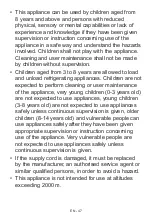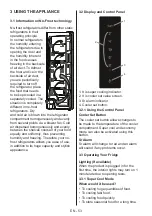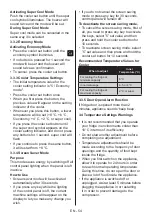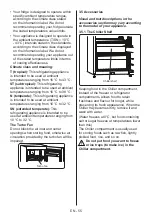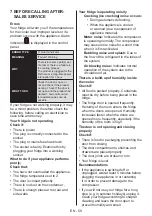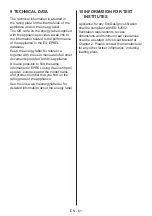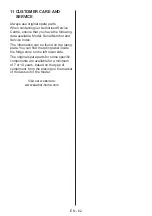
EN - 57
• Do not put food in front of the air flow
passage.
•
Consume packaged foods before the
recommended expiry date.
NOTE
: Potatoes, onions and garlic
should not be stored in the refrigerator.
•
For normal working conditions, it will
be sufficient to adjust the temperature
setting of your refrigerator to +4 °C.
•
The temperature of the fridge
compartment should be in the range
of 0-8 °C, fresh foods below 0 °C are
iced and rotted, bacterial load increases
above 8 °C, and spoils.
•
Do not put hot food in the refrigerator
immediately, wait for the temperature
to pass outside. Hot foods increase the
degree of your refrigerator and cause
food poisoning and unnecessary spoiling
of the food.
• Meat, fish, etc. should be store in the
chiller compartment of the food, and the
vegetable compartment is preferred for
vegetables. (if available)
•
To prevent cross contamination, meat
products and fruit vegetables are not
stored together.
•
Foods should be placed in the refrigerator
in closed containers or covered to
prevent moisture and odors.
The table below is a quick guide to show
you the most efficient way to store the
major food groups in your refrigerator
compartment.
Food
Maximum
storage time
How and where to
store
Vegetables
and fruits
1 week
Vegetable bin
Meat and
fish
2 - 3 days
Wrap in plastic foil,
bags, or in a meat
container and store
on the glass shelf
Fresh
cheese
3 - 4 days
On the designated
door shelf
Butter and
margarine
1 week
On the designated
door shelf
Food
Maximum
storage time
How and where to
store
Bottled
products
e.g. milk
and
yoghurt
Until the
expiry date
recommended
by the
producer
On the designated
door shelf
Eggs
1 month
On the designated
egg shelf
Cooked
food
2 days
All shelves





